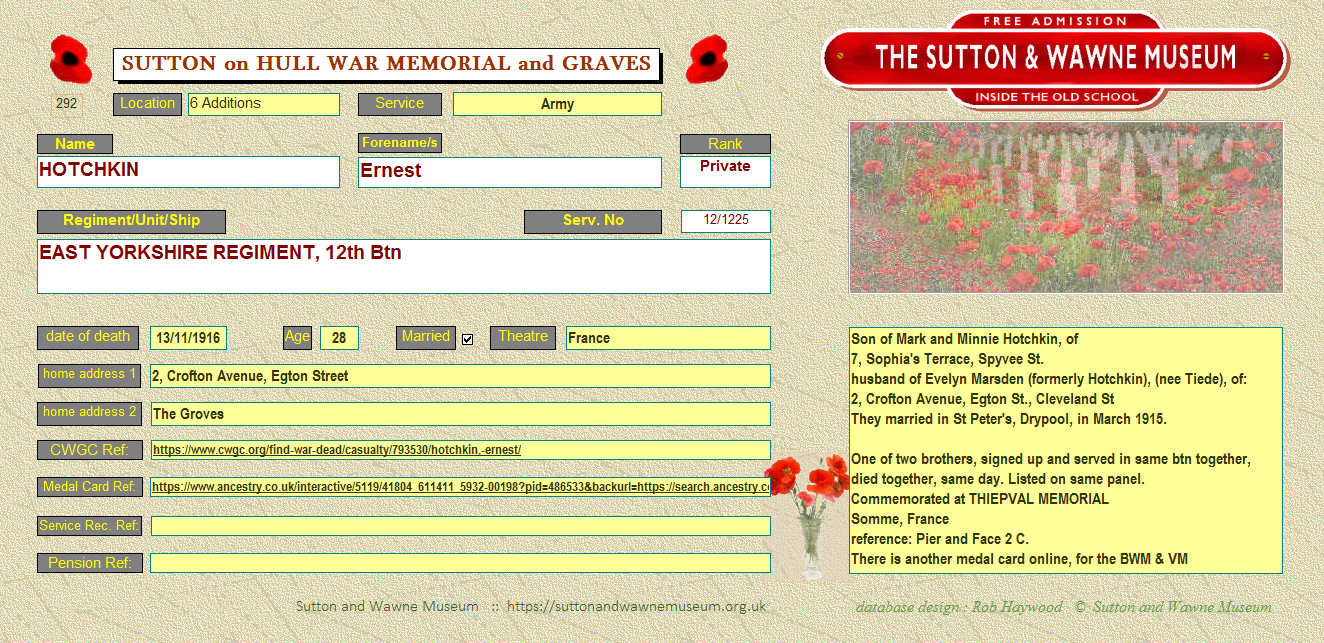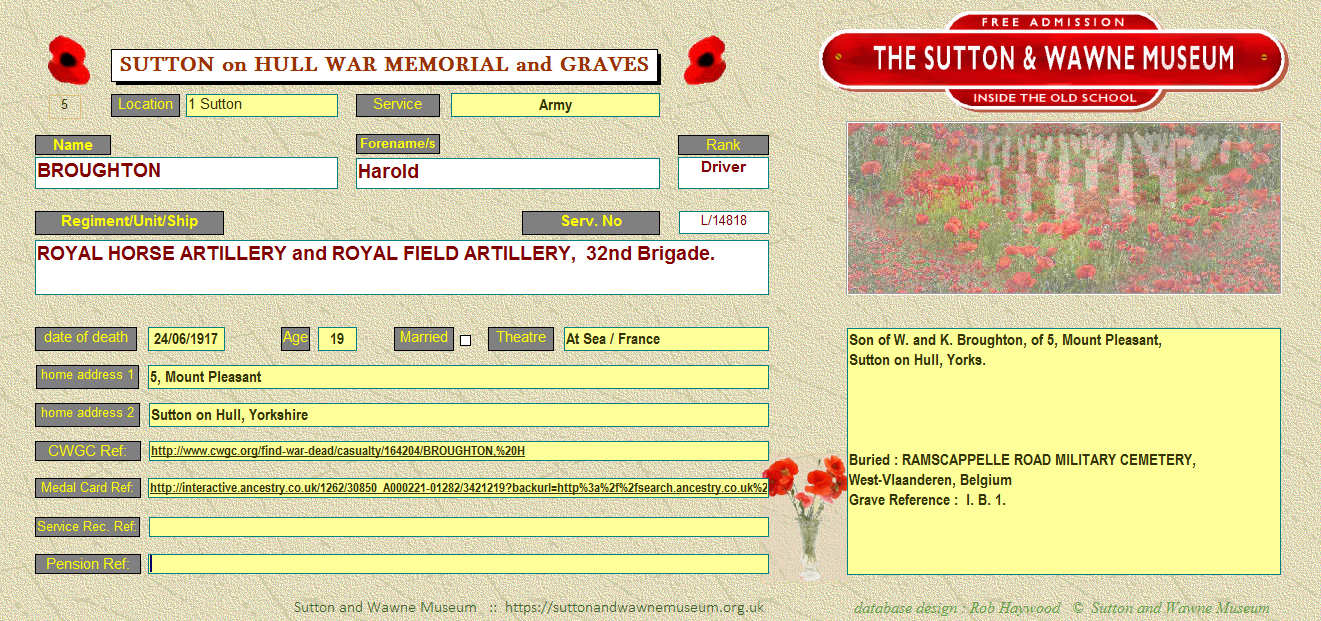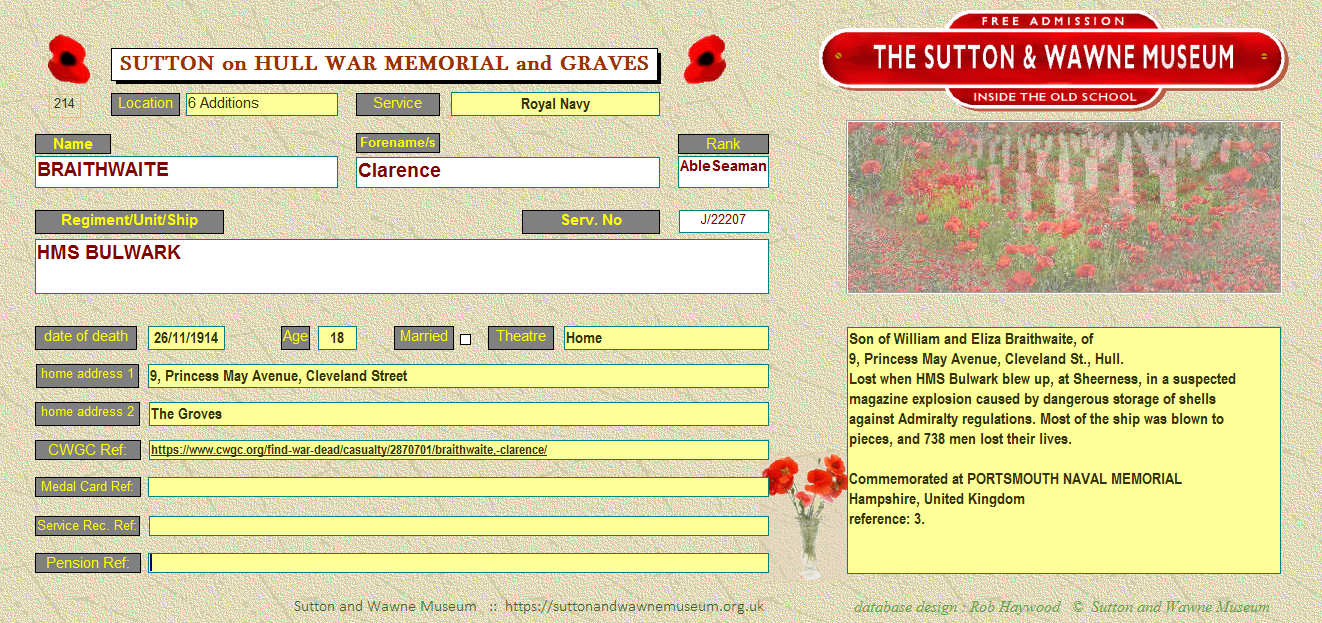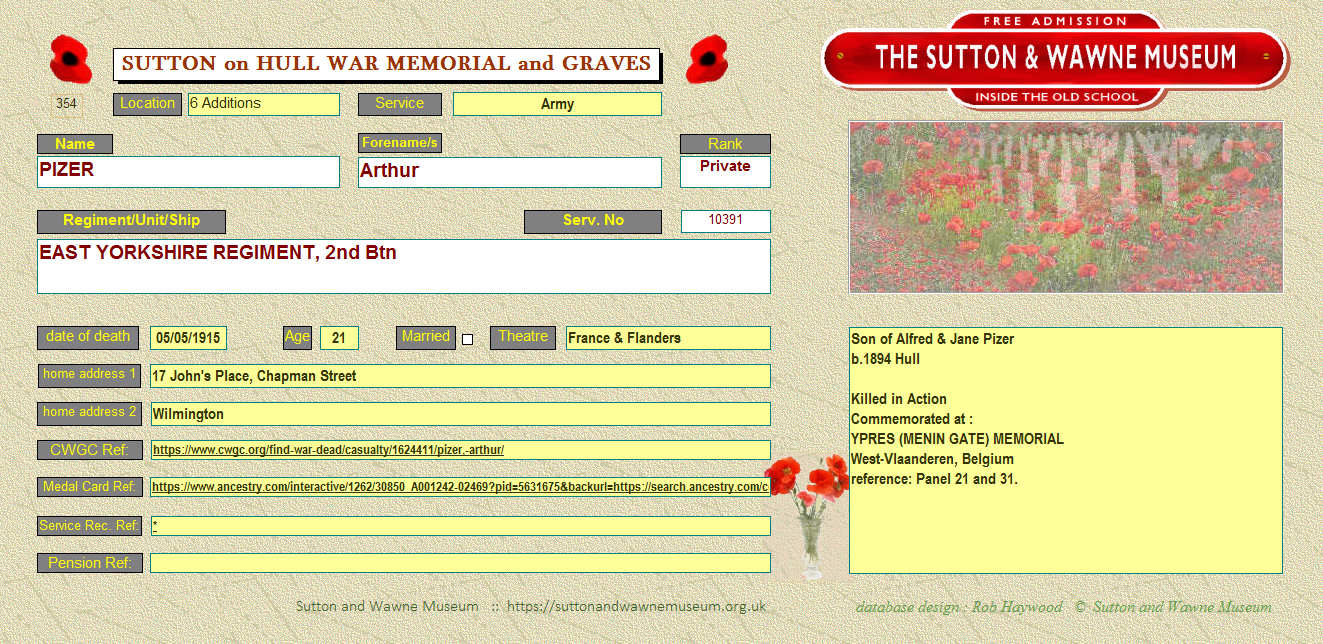  Home Page Main War Memorial Page   SUTTON WAR MEMORIAL 2014-2018 a page of sample data sheets, raised in a new database for each soldier or sailor killed. These are available to view for free inside the museum, generally on Fridays. Eventually, there will be one sheet for each of the 406 men we now have in total. These include the 224 men who were originally missed off the lists and memorials that were first consecrated for St Mark's in the Groves and St Saviour's at Wilmington. In the first place, the samples posted here to view will be from those 224. The rest will be copied and other examples posted here in the fullness of time. Each sheet is presented here as an image, as a photo, and is made to show at a reasonable size to read when displayed full screen. Each is heavily compressed, at 30%, to reduce the file size, which is still considerable with limited webspace. The details on each sheet cannot be edited, but would be okay to copy and save as a sheet for your family history records if you want them. If we change, correct or add to the detail, we will have to make a new image and replace it here. These are purely examples, to show what information we have in the museum. With limited space on the website, we cannot show them all, and I envisage no more than perhaps two or three dozen of the total to be displayed here at any one time, with files changed from time to time. As with most of our records, folks will need to come to the museum to view and research the database. But in the fullness of time, we will have a dedicated Roll of Honour folder inside the Old School of all 406 of these files. Each sheet is shown in numerical order, just as listed in our database, and because they will eventually be the composite total of four separate lists, they are not in alphabetical order. The order is purely a quirk of how we have had to assemble the database together from those four lists to make it easy for us to keep track of who was who and which record is where. The first 36 are all men on the Sutton village memorial. Our original lists with St Mark's, Wilmington and Stoneferry included totalled 182 men. So the two-hundred and twenty-four men we are adding now start at number 183. We hope that explains the numbering, which is ours and nothing to do with the military. Passing your mouse over an image will give you the surname and file number.          


|
| THE WAR GRAVES IN
SUTTON CHURCHYARD There are in total nineteen
official war graves and memorials in
Sutton-on-Hull churchyard. This page has been
amended, because as has been pointed out, there
are three men who died during the First War who
are buried in family graves rather than under
the more recognisable Commonwealth War Graves
headstones. There are also one other family
grave, and one family memorial containing two
names. The names of the 7 men added are in the top panel just above here.
 There are fourteen CWGC
headstones, of which six are from the Great War,
and eight from the Second World War. All six of
the GWGC Great War graves are of men not of this
local area, though two of them were in what may
be described as our 'local' unit, the East
Yorkshire Regiment. The remaining four were in
other units, the Lancashire Fusiliers, the
King's Own Yorkshire Light Infantry, and the
Machine Gun Corps. As far as we can tell, sadly,
there are no surviving 'full service records'
for any of them. So we cannot be sure where any
of them actually came from. There are fourteen CWGC
headstones, of which six are from the Great War,
and eight from the Second World War. All six of
the GWGC Great War graves are of men not of this
local area, though two of them were in what may
be described as our 'local' unit, the East
Yorkshire Regiment. The remaining four were in
other units, the Lancashire Fusiliers, the
King's Own Yorkshire Light Infantry, and the
Machine Gun Corps. As far as we can tell, sadly,
there are no surviving 'full service records'
for any of them. So we cannot be sure where any
of them actually came from.Although they are buried here, those from 'away' are almost certainly remembered in their own home towns or villages on their own memorials, just as Sutton men are remembered on ours. Should someone recognise a name, and seeing the regiment and service number then realise it is the same man, we'd be grateful if they could let us know. Otherwise, it's a case of wait and see if, one day, any of their family contact us, from which we may glean more information. The eight men buried here from the Second World War are also mainly from away, one of them from a long, long way away. One is again from the East Yorkshire Regiment, and one each from the Royal Engineers and Royal Artillery. Two are from the Royal Army Service Corps, and three from what was then the newest service of all, the Royal Air Force. Two of those, we think, were based at the local air station, RAF Sutton on Hull, which was in fact the base of a barrage balloon squadron for the provision and maintenance of the barrage balloons that protected Hull from low level air attack. It is not widely known that several RAF men were killed during Hull's blitz when manning barrage balloon sites ashore around the city, or on the barges moored in the Humber. It's even more difficult to find details on seven of these men because their Second War service records are not yet generally available to the public, only to their immediate families. But we know a good bit about the eighth, paradoxically because he was from the furthest away. He was an Australian airman, a pilot killed in the Battle of Britain, who lies in our churchyard only because he married a local girl when he was stationed in Cornwall. He died in a head-on collision between his Spitfire and a Dornier, over Surrey, and because his next of kin was now his wife of only six weeks, and she came from Sutton, his body was brought back here for burial. Otherwise, he would have been buried in Surrey, near to where he fell. We have a lot more details about him on this page, HERE. As you can see in the photo above, the City Council have now placed a notice to the churchyard gate, pointing out that there are Commonwealth War Graves inside the churchyard to the rear. You'll see the gate when in the car park in front of the Church Hall. It is hoped that folk who visit our newly refurbished memorial will also take the time to pop into the churchyard, just at the back of the memorial, and remember our 'other seventeen' servicemen, and perhaps leave a flower. Of course, Sutton folk have known of the existance of these graves all along, and it is merely an accident of geography and design that with the memorial being totally enclosed by trees and shrubs, the cemetery itself is 'hidden away' around the back. So visitors may not realise that it is there, let alone how to get into it. At first glance, the walkway up the ramp to the church hall looks as if it may be a private drive. And yes, if visiting the churchyard, you can park there. If you do, please be aware that parking is very limited, so please do park 'tidily' with consideration for others. There is another free car park just the other side of the Old School and Museum. This Google Map is now more up-to-date, with the memorial itself easily viewed even from this angle. Even so, when standing inside the memorial garden, there is little clue as to what resides behind the high brick wall at the back. Perhaps this image will help. Since this image was posted, the bus stop has been moved some distance 'behind' the camera.  The way up the side ramp to our cemetery (picture courtesy of Google Maps) A page of photos of all the war graves in our churchyard, and further web links, can be seen HERE Home Page Main War Memorial Page |
| REMEMBRANCE
SUNDAY 2013 A few images of last year's Remembrance Service at the Sutton on Hull War Memorial There are a few more photos of the service on Monday evening, August 4th, on our Facebook page.    click individual smaller images for a slightly larger version Use backspace button when done. Use F11 to hide toolbars. another useful tip: Ctrl+F4 closes a tab window without closing the programme 

 


 The photo above is of
Sutton churchyard from a more unusual
direction. It has often occurred to me that
men with surnames that are at the end of the
alphabet always did get a raw deal when
privileges and goodies were being handed out.
The last to sign the register at school, last
for dinner, the last in a named line-up in the
forces, last in everything. And so it has
often seemed to me in the case of our war
dead, and the guys that come at the end of any
list. Last in life, and then last in death as
well. So it must have always seemed for Robert
Wright. This is his headstone, sprinkled here
with dappled November sunlight in the darker
corner at the very north end of the
churchyard. Probably the last war grave, in
the far end of the churchyard, almost out of
sight to most of our frequent visitors. In
fact, none of the war graves are together, in
a formal group. They are sprinkled around
individually, buried where the next plot
became available at the time of their deaths.
We in the museum have just embarked upon a lengthy project to compile a modern database of all of Sutton's war dead. In a four year rolling project, we hope to find and publish all the known details of every name on our memorial. Not just an initial and a surname, but who they were, where they or their parents lived, what regiment or ship, and if possible, when and how they died. So that's why I include Robert Wright here. By definition, and his name, he is at the end of our list for WW1. But just for once, let him be first. Lest we Forget.
 |
|
MORE PHOTOS
each opening in a new window. Use F11 to hide toolbars. another useful tip: Ctrl+F4 closes a tab window without closing the programme 



 If you press F11, or select View - Full Screen, these photos will appear without the encumbrances of the top toolbars. Just pressing F11 again brings them back. Home Page Main War Memorial Page |
|
1938 and All
That
|








